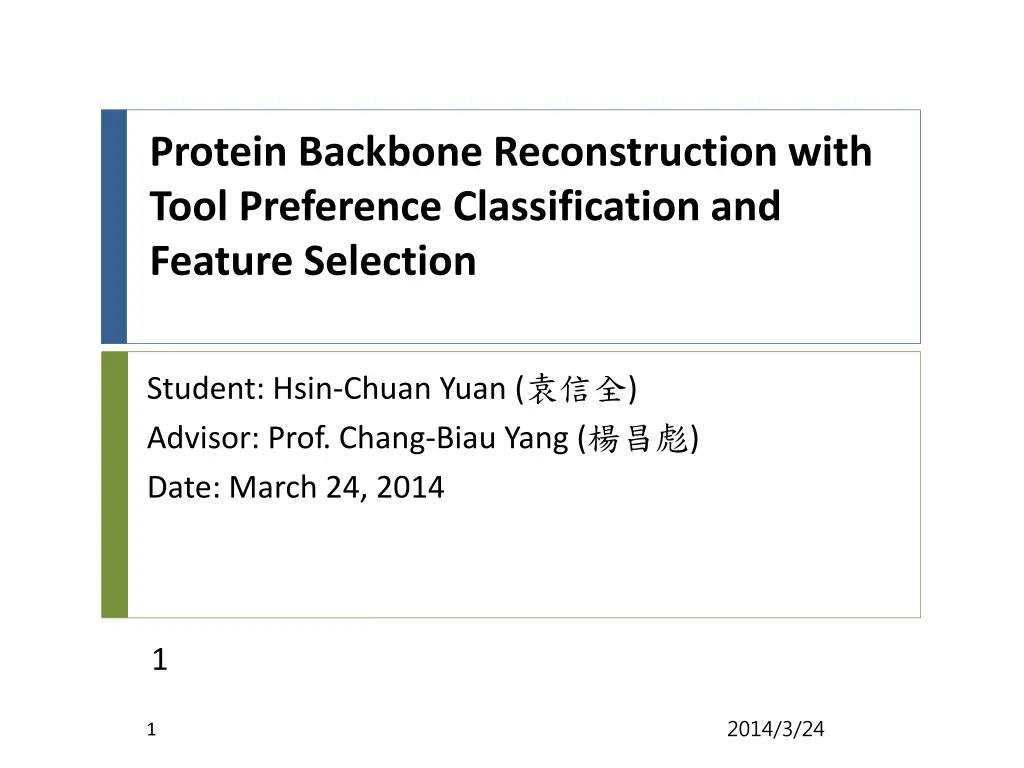
Protein Backbone Reconstruction Tool Preference
Explore protein backbone reconstruction with tool preference classification and feature selection. Learn about amino acid abbreviations, peptide bond structure, RMSD, SVM, and previous research methods. Our method offers a new approach to protein structure analysis.
Download Presentation

Please find below an Image/Link to download the presentation.
The content on the website is provided AS IS for your information and personal use only. It may not be sold, licensed, or shared on other websites without obtaining consent from the author. If you encounter any issues during the download, it is possible that the publisher has removed the file from their server.
You are allowed to download the files provided on this website for personal or commercial use, subject to the condition that they are used lawfully. All files are the property of their respective owners.
The content on the website is provided AS IS for your information and personal use only. It may not be sold, licensed, or shared on other websites without obtaining consent from the author.
E N D
Presentation Transcript
Protein Backbone Reconstruction with Tool Preference Classification and Feature Selection Student: Hsin-Chuan Yuan ( ) Advisor: Prof. Chang-Biau Yang ( ) Date: March 24, 2014 1 2014/3/24 1
One-letter Abbreviation Three-letter Abbreviation Amino Acid Introduction (1/3) 1 Alanine A Ala 2 Cysteine C Cys A protein is a consecutive chain of amino acids. 3 Aspartic Acid D Asp 4 Glutamic Acid E Glu 5 Phenylalanine F Phe 6 Glycine G Gly 7 Histidine H His 8 Isoleucine I Ile 9 Lysine K Lys 10 Leucine L Leu 11 Methionine M Met 12 Asparagine N Asn 13 Proline P Pro 14 Glutamine Q Gln 15 Arginine R Arg 16 Serine S Ser 17 Threonine T Thr 18 Valine V Val 19 Tryptophan W Trp The fundamental structure of Valine. 20 Tyrosine Y Tyr 2
Introduction (2/3) Peptide bond and backbone 3
Introduction (3/3) Protein Backbone Reconstruction Problem (PBRP) Input: A protein sequence and its all C coordinates. Output: The coordinates of N, C and O atoms on the backbone. 4
Root Mean Square Deviation (RMSD) The RMSD is a measure of similarity between a predicted structure and a real one. RMSD formula: 1 n = i = 2) A i B i ( RMSD X X n 1 5
Support Vector Machine (SVM) SVM is a supervised learning model which can be applied to classification or regression. 6
Previous Work (1/2) Chen determines the tool to be used on N, C and O atoms of each protein. The feature vectors were derived from a coding rule which applied on the properties of amino acids of each protein. 7
Previous Work (2/2) Wu determines the tool to be used on all atoms of each residue of the proteins. The feature vectors were derived from the properties of amino acids of each protein and the properties of the adjacent amino acids . 8
Our Method (1/3) It is based on Chen s method and Wu s method which determines the tool to be used. We further use 135 properties of amino acids as the training feature. In order to balance the significance of each property of amino acids, we modified Wu s method on the feature vectors by normalizing the properties. We aim to select significant property from the 135 properties to obtain higher accuracy and increase the efficiency of the process. 9
Our Method (2/3) A grid-search technique was used to determine the best parameters, cost and gamma. The two parameters were limit in 2-10to 2-5and 2-3to 22, respectively. 10
Our Method (3/3) Fisher score and distance correlation are also applied on our method to determine a method on selecting crucial features. However, the two method is not suitable for our case. 11
Experimental Results Self-test Training Set Testing Set BBQ Chang s Method Chen s Method Wu s Method Our Method CASP7 CASP7 0.3624 0.4108 0.3505 0.3355 0.2659 CASP8 CASP8 0.4584 0.4888 0.4106 0.4379 0.3443 CASP9 CASP9 0.4280 0.4406 0.3693 0.4293 12
Experimental Results Independent test Training Set Testing Set BBQ Chang s Method Chen s Method Wu s Method Our Method CASP8 0.3589 0.3636 0.3661 CASP7 0.3624 0.4108 CASP9 0.3609 0.3632 0.3632 Training Set Testing Set Chang s Method Chen s Method Wu s Method Our Method BBQ CASP7 0.4558 0.4589 0.4536 CASP8 0.4584 0.4888 CASP9 0.4187 0.4590 0.4590 Training Set Testing Set Chang s Method Chen s Method Wu s Method Our Method BBQ CASP7 0.4127 0.4334 0.4363 CASP9 0.4280 0.4406 CASP8 0.3757 0.4297 0.4372 13
Conclusion We only get better result than Chen s result in CASP7-CASP7. We get better results than BBQ s results in CASP7- CASP7 and CASP8-CASP8. The other results are better than Chang s results but worse than BBQ s and Chen s results. 14
Future Work Find more useful features to improve our model. Change the method of normalization. Add probability feedback method to converge the result. Determine the tool to be used on N, C and O atoms for each residue of the protein. 15
